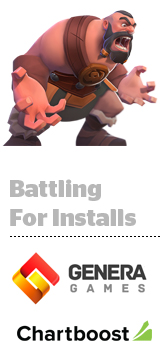
Influencer marketing often gets lumped in with vapid Kardashian nonsense, PewDiePie antics and top-of-the-funnel fluff. But there’s no reason sponsored videos can’t be a data-driven user acquisition (UA) channel for performance-minded marketers.
User acquisition is about knowing where your audience is, wherever that may be, and being willing to experiment, said Danika Wilkinson, community manager at Genera Games, a Spanish game publisher whose titles have been downloaded more than 100 million times.
“More and more, mobile performance is about interactive content, things like video,” she said. “And when you’re working in an industry like ours, where your users are quite technologically savvy, you’ve got to be open to staying ahead of the curve, even if it seems like a gamble.”
And it often is.
Working with an influencer in the game space has the potential to generate a large number of installs over a short period of time, which can be handy for promoting a new game and boosting the charts, but marketers need measurement to prove the value.
Genera usually spends most of its UA budget on Facebook – mainly because it’s easy to calculate the cost per install and manage bids accordingly. It’s safe, but every channel has its saturation limit.
Last May, Genera included influencer videos in a campaign to promote its then-new strategy title, “Gladiator Heroes.” The studio partnered with mobile game discovery platform Chartboost to produce the content and create tracking links that tied installs to individual videos.
Chartboost also helped Genera identify the right YouTube channels to work with, which almost served as a form of audience targeting.
The “right” creators aren’t usually in the mainstream and don’t have tens of millions of followers like the PewDiePies of the world, but they do have loyal fan bases. In many cases, glomming onto a creator with 500,000 ardent subscribers can drive better engagement and return than creators with larger audiences, said Pepe Angell, VP of corporate strategy at Chartboost.
Marketers that work with the larger channels are often frustrated because they don’t get the ROI they were expecting, Angell said.
Chartboost found two YouTubers for Genera to work with: Oompaville, a gamer with more than 530,000 subscribers who makes comedy videos, and Chief Pat, a gamer with more than 2.5 million subscribers who usually specializes in “Clash Royale” content.
Oompa’s video was fully dedicated to the game (he even dressed up like a gladiator at the beginning), and Chief Pat’s was just a quick shout-out, but both drove installs. The Oompaville content generated a 40% click-to-install rate, and Chief Pat was in the same neighborhood in terms of engagement.
“That’s not to mention the halo effect that comes from recommendations and people sharing the video,” Angell said.
Genera was aiming for a blended cost per install – meaning the amount of marketing spend per all acquired users, including those that downloaded the game organically – of $1, which is on par with what Genera usually sees on its Facebook campaigns.
In the end, the CPI came out to $2, which meant Genera only made just enough revenue to cover costs, but it learned from the experience.
For example, the brief mention in Chief Pat’s video was cheaper than the full-length Oompaville video and drove very similar engagement. With that in mind, Genera only paid for mentions in its follow-up campaign, which was more cost-effective while still generating conversions.
Genera also recalculated its spend versus campaign goals and came out with a CPI of $1.08.
In other words, Genera was ultimately able to open a new acquisition channel at a CPI it was comfortable with.
Wilkinson was pleased with the results, but she’s also a realist. Influencer marketing isn’t for everyone.
“Some marketers just don’t want to pay a 20-something-year-old thousands of dollars for a short video of him mucking around with his mates,” she said. “But that’s the way the internet works today, especially if you’re targeting a younger audience.”
The point with UA is to stay nimble, Wilkinson said. Platforms fall in and out of favor, and game marketers need to be flexible enough to jump to the hot new platform, whatever that may be, she said.
“‘Gladiator Heroes’ is a strategy game and the users we’re looking for are on YouTube,” Wilkinson said. “But you never know where your users might be from one day to the next. We don’t plan our influencer marketing campaigns more than two or three months in advance. You never know what’s going to happen.”
This post was syndicated from Ad Exchanger.

More Stories
What Media Rights Deals Mean to the Future of Women’s Sports
Gray Promotes Dana Neves to Senior Managing VP
WPP’s Q1 Revenues Slide 5%, but Tariffs Aren’t to Blame